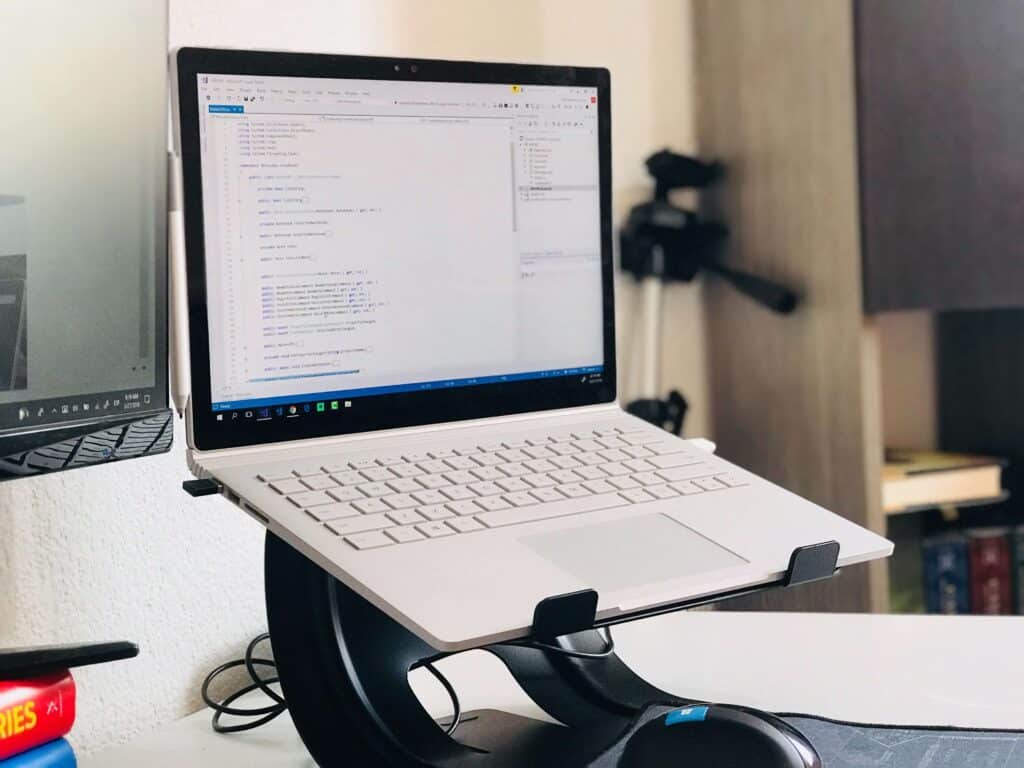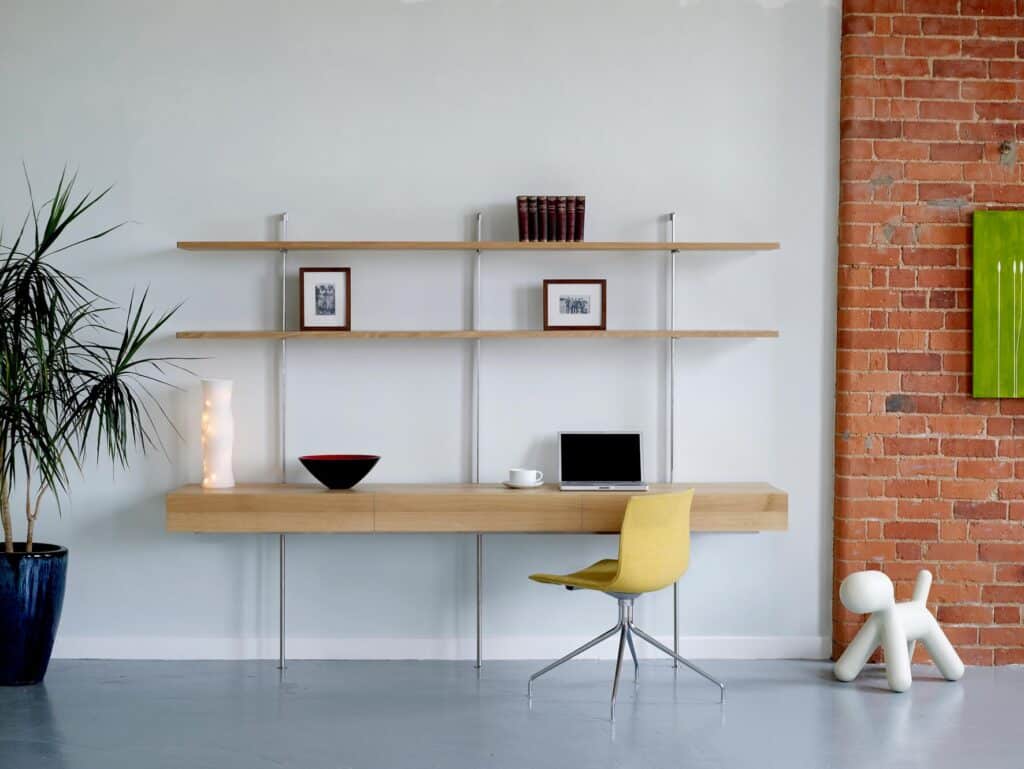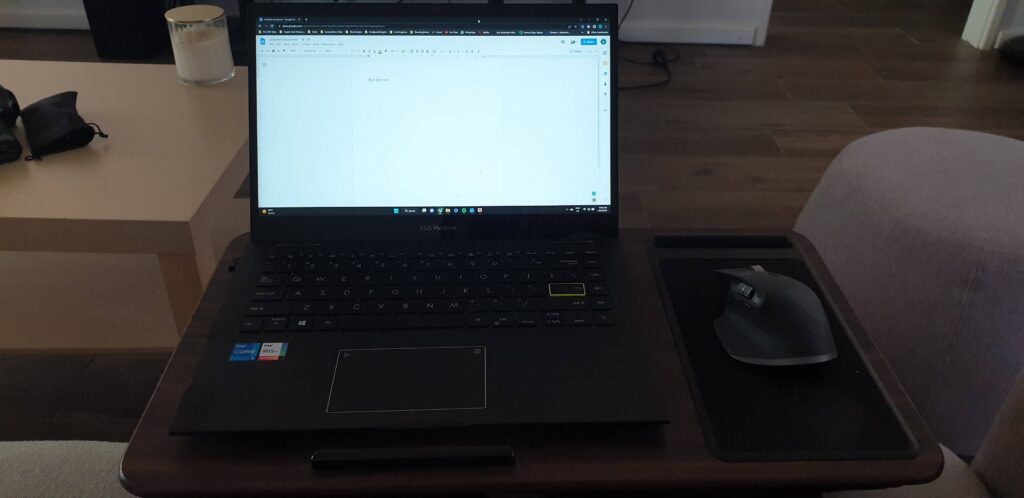Standing Desk Alternatives For a Small Workspace
A full-standing desk may not fit small spaces as most measure anywhere between 100 and 200cm. While a larger sit-stand desk isn’t ideal for tight spaces, you may still see the benefits of standing while working when you get creative. Even a tiny workspace can offer enough space to fit either portable solutions or even temporary retractable desks which are even cheaper alternatives than a new desk.
Key Takeaways
- Desk converters and laptop stands are common alternatives to standing desks in small spaces.
- Wall-mounted desks are valid options for tight spaces.
- Small desks may or may not elevate similarly to a standing desk.
Best Alternatives To A standing desk
Similar to a traditional desk, the standing desks are practical but might be too large for small spaces at the office or in a makeshift home office. While there are premium standing desks on the market, they may not be suitable from a cost or size perspective. Here are some of the best alternatives you can consider to stand while working in a limited space.
1. Desk converters
Desk converters offer all of the benefits of standing while working at the computer while they also save space. Designed for a small space, desk converters can be added to your existing desk or even on a small table. A small rising desktop makes these desks ideal for alternating sitting and standing when available space is tight.
Most of the popular desk converters aren’t electric but some of the best are. They use pneumatic systems to adjust by height, which means they don’t require electricity to adjust. Also known as a desk riser, desk converters are only height adjustable from the surface you place them on, either a standard desk or a table. A limitation of desk converters compared to full-standing desks include lower maximum weight capacity. A maximum load of around 50kg is specific to desk converters such as The UpDown Memory Electric Sit Stand Workstation.
Average size – 72 x 60cm
Price range – $100 to $700

Desk Converter Pros
- Made with an ergonomic design for easy typing.
- Fully adjustable for working while standing.
- Durable pneumatic adjustability systems.
- Easy to fold and carry around.
Desk Converter Cons
- You still need a desk or table as a stable surface.
- Limited choice of materials.
- Standing desk converters can be wobbly.
2. Laptop Stands
A laptop stand is a type of elevated surface that brings the laptop higher, possibly suitable for working while standing. Unlike a standing desk converter, laptop stands are typically fixed in height and not adjustable. Often seen as a portable standing desk for its reduced weight, a laptop stand can replace some of the more expensive fixed-height standing desks.
Some of the limitations of laptop stands include the inability to adjust the height up and down. A standing desk riser costs more but allows users to set different elevations, similar to standing desk options.
Average size – 10 to 43cm height adjustments
Price range – $20 to $200

Laptop Stand Pros
- Compact and often foldable.
- Some of the best laptop stands can adjust by height.
- Manual height adjustments that don’t require electricity.
- Can be used in conjunction with standard desks and sit-stand desks.
Laptop Stand Cons
- Not all laptop stands are height adjustable.
- An external keyboard is required for typing.
- Not the most stable surface.
3. Wall-mounted/floating desks
Tight spaces such as corners or even an area of a living room or a bedroom can be turned into a temporary desk with a wall-mounted floating desk. Unlike expensive standing desks, floating desks are a type of compact piece of office furniture office workers use temporarily.
While attached to a wall, floating desks come with similar standing while-working health benefits to a standing desk. Some of the limitations of these systems include the lack of a dedicated keyboard and mouse tray or the limited space for a dedicated monitor. They are more suitable for laptops than desktop computers.
Average size – 70 x 40cm
Price range – $50 to $400

Wall-mounted/floating desks Pros
- It saves space replacing a regular desk.
- It creates a desk space in almost any room.
- More space for other office furniture.
- Available at a fraction of a cost of a full-standing desk.
Wall-mounted/floating desks Cons
- No separate keyboard tray.
- Low weight capacity.
- Not as heavy-duty as traditional desks.
4. Balancing and lap tables for laptops
A lap desk is a type of elevated flat surface made for working while sitting on an armchair or on the bed. A standing position is not supported by lap tables. Like some floating desks, lap tables for laptops come with limited height range adjustability, mainly suitable for working while in bed. They show lower cost alternatives exist to standing desk raisers.
Average size – 50 x 27cm
Price range – $30 to $200
Lap Tables Pros

- Compact and easy to use in bed.
- Ideal tight budget desk.
- Made from a wide range of materials from plastic to natural bamboo.
- It can be used as a monitor raiser on a kitchen table or on a dining table.
Lap Tables Cons
- Made for beds, rarely compatible with a height-adjustable chair.
- Always in the same position for typing in bed.
- No included monitor riser.
5. Portable standing desks
Other desks such as portable standing desks are also compact alternatives to electric standing desks or manual desks to work from home.
Small desks for beds such as those made by Movel or an Ikea standing desk for bed and armchair use are example desk setup ideas for small spaces and for laptop users. The only downside to these systems is most are made for working in a sitting position as few can elevate to support working in a standing position.
Average size – 50 x 65cm
Price range – $50 to $500
Portable standing desk Pros
- Stable top shelf for typing and working at the desk.
- The ideal standing desk height can be adjusted based on preset positions.
- Ideal for small home offices.
Portable standing desk Cons
- No pre-drilled holes for cable management.
- Not the most stable desk for typing for long hours.
- Limited choice of desktop materials.
6. A Smaller normal desk
Buying a standard non-height adjustable desk of a smaller size is another option for small spaces. Some of the smallest desks can fit corners or small spaces. The benefits of a small normal desk include a wide range of materials and designs to create a more personalized office working space.
Average size – 70 x 30cm desktop
Price range – $50 to $600
Small Desk Pros
- Sturdy work surface for any type of computer work.
- Plenty of materials and colours to choose from.
- One of the cheaper alternatives to standing desks.
Small Desk Cons
- No sit-stand desk height adjustments.
- It can feel too small, unlike a sit-stand desk.
- Many small desks look more like small dining tables.
Things to consider when choosing a standing desk for a small area
A good sit-stand desk alternative needs to be practical, especially in small spaces. Here are some of the most important considerations when choosing another type of desk for small spaces.
The Available Sizes
Small spaces can benefit from using a compact desk or a small desk alternative. A desk with a length of up to 170cm is considered small so make sure you factor in a position for a desk chair or for standing when calculating desk size compatibility in a small space. A standard standing desk size measurements are between 1.2 and 2m, their alternatives should be shorter
Ability to adjust the height
A standing desk’s height adjustability is its most important function whereas not all of the desk’s alternatives feature adjustable height. Standing desk converters typically feature adjustable height while small standard desks and wall-mounted desks come without height adjustability. Some laptop stands can adjust to a maximum height of around 43cm while others have a fixed-height design. The best way to turn any desk into a height-adjustable desk is to use a desk converter
Stability
Most standing desk alternatives aren’t as stable as an actual standing desk. Make sure you check the maximum load capacity to have a better idea of the desk’s stability. A metal frame is recommended as a heavy base for extra stability. Choosing the widest possible desk in a small space is one of the strategies to improve stability according to small space limits.
Portability
A standing desk isn’t made to be portable. Its alternatives list portability among the main benefits of choosing a smaller desk. A standing desk converter is portable due to its foldable design and reduced weight. Laptop stands are even more portable as they are lighter and small. A small standard desk can be smaller than a standing desk, but it’s not designed to be frequently moved around.
Level of comfort
A relaxed typing position at the desk that’s also ergonomic is specific to a standing desk. Comfortable alternatives often need to come with similar benefits. A comfortable sit-stand desk alternative needs to allow both standing and sitting but more space doesn’t always equal more comfort. Standing all day is not good for your health, just as sitting all day – make sure there’s space for a dedicated office chair alongside your standing desk alternative
Cost
The cost of a standing desk is typically greater than its desk converter cousin. A standing desk converter tends to cost more compared to other standing desk alternatives, but it also features the most adjustability. A higher cost of standing desk converters is often associated with extras such as having a keyboard tray or the possibility to add a monitor stand. For those on a budget, you can also check out Officeworks standing desks which are economical.
Conclusion
A standing desk alternative for small spaces needs to be practical, and smaller, but also stable and durable. From desk converters and laptop stands to wall desks and small standard desks, you should ensure there’s sufficient room for your perfect alternative and for an office chair for comfortable working both while standing and while sitting. If none of these alternatives suit, you can also consider an exercise ball. To help you decide, here’s a detailed comparison of a standing desk vs an exercise ball, with the latter being a good way to remain active at a standing desk.
Frequently Asked Questions
Standing desk converters are ideal for small spaces where the use of a full-size standing desk isn’t possible. Unlike standing desks, converter desks are small and can be folded away for storage. They are ideal for a laptop or a 1-2 monitors computer setup.
A laptop stand is a simpler version of a standing desk converter. It only holds laptops but it doesn’t offer support for typing, such as a standing desk converter.
A standing desk converter typically rises to 50cm. This is the distance from the flat surface it sits on, typically a table or a standard desk.
A standing desk can be placed on any part of the table. Pushing it back is recommended as the display should be in the 50 to 100cm distance from the face for proper standing and sitting ergonomics.